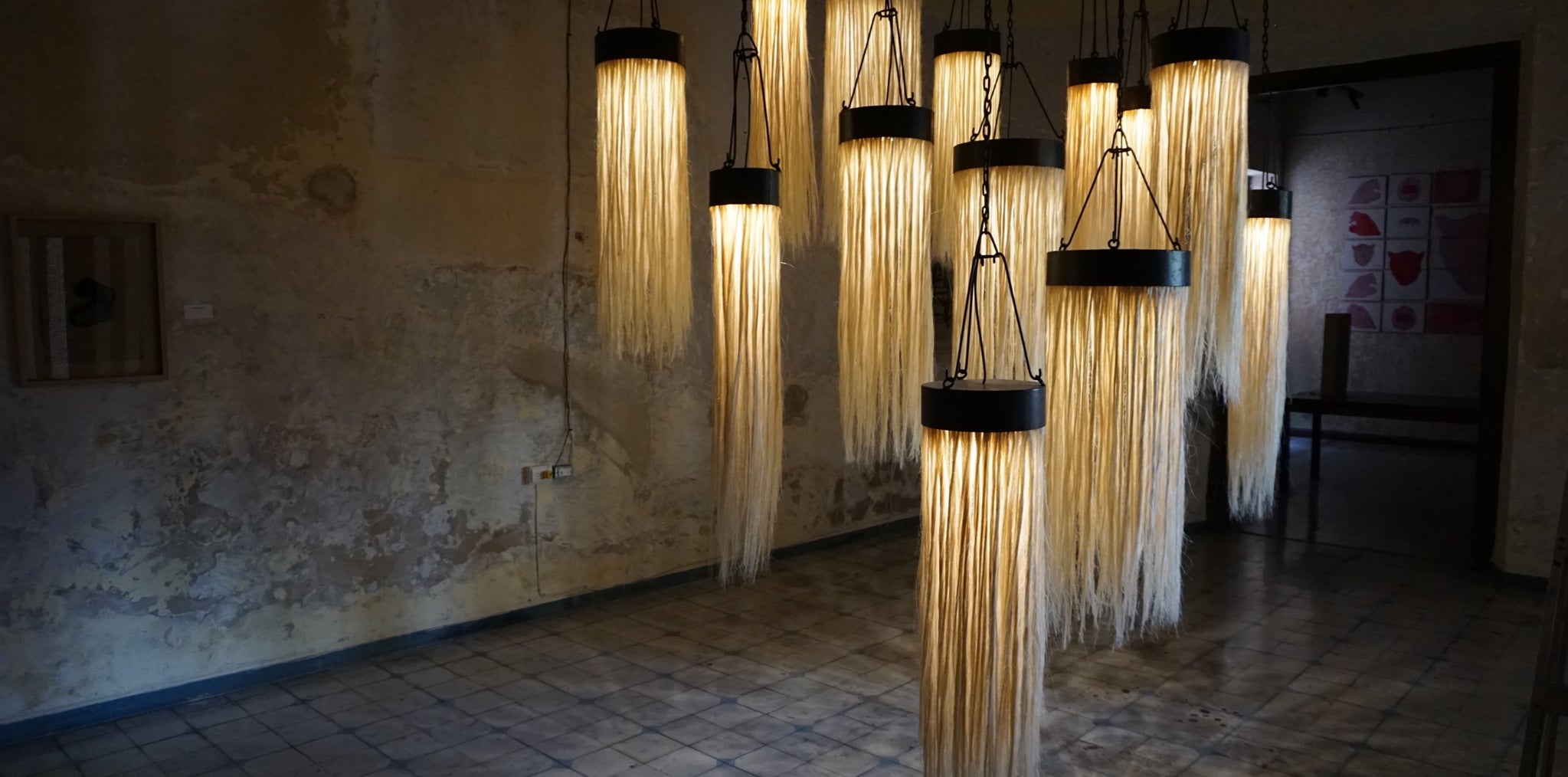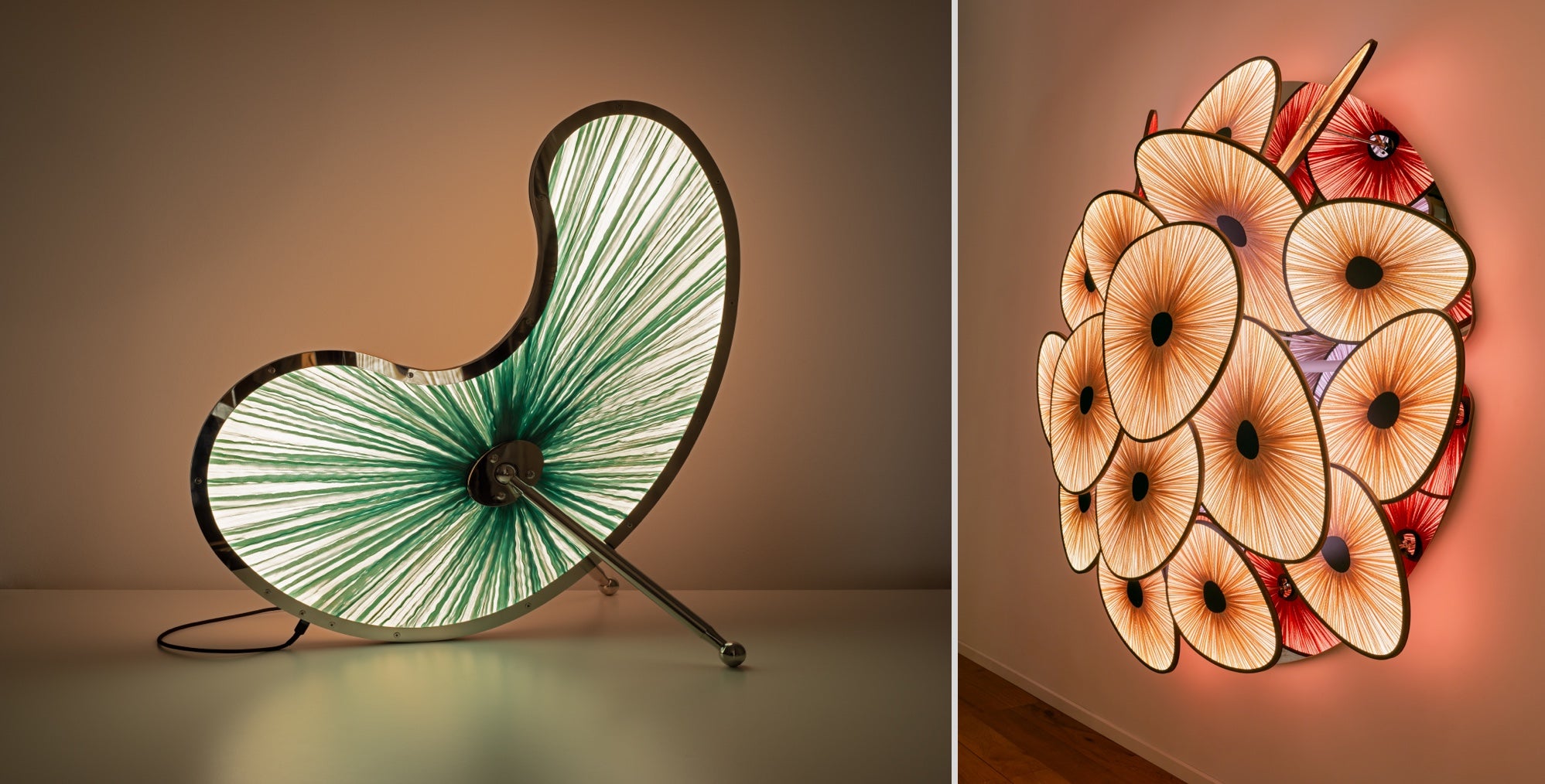
Glowing Up
When it comes to blurring the line between art and illumination, three artists and designers are lighting the wayGallery art objects are most often divorced from the functions of our everyday lives, beyond the concepts and aesthetics that adorn our homes with beauty and meaning. Sometimes it’s easy to forget that they don’t have to be. Take, for instance, the electric lamp. Since the 1920s, when tungsten made light bulbs cheaper and more stable, lamps have been a mainstay part of nearly every home. But luminaire (as is the technical term for electric lamps) can be artworks unto themselves, imbued with as much meaning as function, whether they’re vehicles for storytelling, experiments in unusual materials, or missives about the state of our planet. Here, we look at three artists who work in the medium of light.
Angela Damman
In the jungle outside of Mérida, in the southeastern state of Yucatán in Mexico, Angela Damman’s hacienda is humming with activity. In particular, a defibering machine hums in the background as she talks, stripping the fibers from the sansevieria plants she uses to adorn her chandeliers with horse mane–like locks of gossamer tendrils.
“It hasn’t been really exploited or used to any extent other than here they used it as a fire wall for the henequen fields,” Damman says of the sansevieria plant that has become something of her signature. “There was one gentleman who had cultivated it for making wigs—he was from Ohio—because it’s very human hair–like.”
What’s most important for Damman, however, is that the sansevieria, and the similarly fibrous henequen agave she also uses, is as sustainable a crop as it is a beautiful fiber. Also referred to as the snake plant (a common decorative plant known to improve air quality), sansevieria grows with almost no water, and it allows Damman to work steadily with approximately 60 to 80 local artisans on each project. It’s been a big part of her objective since she moved from the U.S. in 2011 after 20 years of work in rural economic development around the world.

“Working with rural communities in the area of agriculture was my profession, but I was also originally going to be a designer and just didn’t find my calling at the time,” Damman, who had previously worked in the global development of renewable energy before pulling up roots from Colorado to move to Yucatán with her husband, says. “And so when I came here, I thought, ‘Wow, there’s so many opportunities to work with the local people. With their knowledge and techniques, what can we design from this to create new markets and opportunities for them and opportunities for me, too?’ I’ve been working with the same artisans from the very beginning, and we have all been able to grow together.”

Some of that growth came from gained interest from the art and design world—she recently showed a dramatic, Cousin Itt–esque chandelier at Design Miami with British gallery Sarah Myerscough Gallery. The six-and-a-half-foot chandelier (painstakingly created with tens of thousands of meters of hand-spun organic fiber) attracted a lot of onlookers drawn in by the glowing fringes, who were then privy to Damman’s sustainable, handmade processes.
“It was an amazing response,” Damman says, “because I live in my bubble here, and I produce my work, and I just never know where it’s going to go. I have my core philosophies, but it’s exciting to see that it’s reaching a new opportunity with these art fairs. It inspires me to continue to keep creating, keep pushing the envelope.”
Aqua Creations
Thirty years ago, after a snorkeling trip in the Red Sea off the Egyptian Sinai Peninsula, Israeli designer Albi Serfaty began his Aqua Creations studio with the intent purpose of creating lighting with marine forms. It was in seeking more aquatic aesthetics that Serfaty began to realize that the waterways he’d seen as an influence were in big trouble. So he began a project with the shapes of Doiran Lake, on the border of North Macedonia and Greece, and Lake Chad, in the northern-central African country of Chad—both of which have shrunk dramatically in the past few years.
“I was using Google Earth, looking for shapes of lakes,” Serfaty says. “I would like to call the lamp “Lake Como” or other sexy lakes like Lake Michigan, but the shapes didn’t work. So I looked for shapes that I could remember, and then I start seeing the lakes [on Google Earth] and I realized that most of them are in trouble. In trouble because of overuse of the water.”

The resulting lake lamps, culminating in an installation at Design Miami called Light on Water, are powerful. They resemble drying lake beds, with the banks sloping down into the center, and are meant to bring an awareness to water supply overuse in freshwater lakes around the world. Another light, a cluster of these lamps flourishing out of lake-like, mirror-like lotus flowers on a pond, is a more optimistic view called Lotus Lake. “Lotus is a symbol of pureness,” says Serfaty.
As much as Serfaty’s dedicated his recent work to water activism (his next project addresses overuse of the Jordan River that feeds the Dead Sea and is called The Dying Dead), he has dedicated just as much to optimism and beauty. Serfaty uses a signature silk to create the lamps, which he calls “tussar silk,” using the cocoons of silkworms from a forest outside a traditional weaver’s village in southern India. The silkworms are allowed to hatch before their empty shells are harvested and made into the delicate silk suitable enough for Aqua Creations’ lamps.
The lamps themselves are breathtaking, whether they’re the large-scale kinetic mobile lights that resemble a piece by Alexander Calder or the Code 130˚ series of colorful pendant lamps that are meant to coax people to look up at them. By creating Aqua Creations’ beautiful, thought-provoking lamps, Serfaty is tapping into something he learned as a photographer—his original career before delving into light design—the idea of focusing and zooming in on something.
“I’m a photographer originally, and photography is: You choose to cut the frame from the world,” Serfaty says of making lights that carry a message within them. “I said, ‘What can I do as a designer?’ A musician would write a song; a writer would write a book or a poem. You just do what you do in your field, and so I said, ‘Okay, I’m doing lights. Talk with the lights.’”
Lauren Elder

In Los Angeles–based ceramicist Lauren Elder’s world, the lamp is a perfect object through which to tell a story. A recent show, The Muse and the Simurgh, at Wilding Cran Gallery in LA, included a lamp formed from the same clay as Elder’s sculptures and vases on nearby pedestals—both capturing a mystery world that feels like finding the antiquities of a long-forgotten culture. A clue lies in the name: The simurgh, a mythological birdlike beast in Persian tales, nods to the histories and narratives of Elder’s roots. Her mother, originally from Iraq and raised in Iran, and her father, Scotland born, both immigrated to the U.S. with their own stories.
“And so it’s how stories are passed on from generation to generation but how I twist in my own ties, and my own worlds, and how they’re engraved and drawn in as if they were hieroglyphics,” says Elder, referencing the act of carving narratives with clay tools into the base of her ceramic lamp bases, which she then fits with a lamp socket and wires.
A new body of work features lamps with personal biographies etched into the tear-shaped ceramic lamp bases. They tell the story of a trip to Palm Springs and the ghosts of “Hollywood cool” that she says the place evinces, down to its mid-century modern architecture and the interiors decorated for a bygone time.
Elder, who studied at the Art Institute of Chicago, says that her foray into lamps was actually born from redecorating her boyfriend’s apartment. But when she looked into the lamps she had her eyes on, she found them to be prohibitively expensive, and so she set out to make some herself in her downtown art studio. It sent her down a path of creating functional objects that fit as well in a gallery setting as they do in a living room. “There’s something really gratifying about an art piece or a sculpture you can live with, but that you can also use,” she says. “I think that functionality makes it more personal.”
Today, she uses her own apartment as an incubator of ideas, and as a study for a future exhibition, but also as a way to turn her apartment into a strange little universe made of ceramic forms and constructions. “I want to have it where you walk in the space and everything is made from ceramics or handmade, where the stories that are drawn onto the vases are like you’re entering into this weird world,” she says. “The lamps play on this role of fantasy, of fantastical things—‘It’s a flower that can light up’—almost like different organisms that engage in this play between functionality and fantasy.”

- Courtesy of Angela Damman
- Courtesy of Aqua Creations
- Courtesy of Lauren Elder






